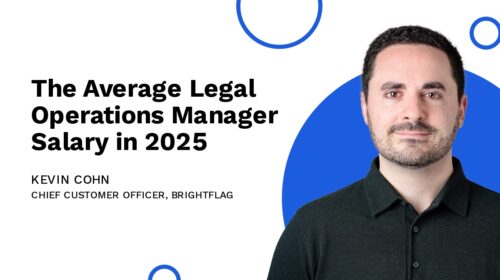Keys to Legal Operations Optimization in 2025
Whether it’s overseeing contracts or keeping up with regulatory deadlines, your in-house legal team is expected to keep a lot of plates spinning. And even as the tasks pile up, you still need to find ways to maximize your resources and boost the value legal adds to the business—also known as legal operations optimization.
In this environment, it’s no surprise that many corporate legal departments are tasking legal operations professionals with looking for ways to streamline the more mundane aspects of legal work, and free the in-house team up to focus on more impactful tasks.
But what’s the best way to accomplish this? It all starts with investigating your options for legal operations optimization to see how your legal team’s workflows could be improved. Here are four tips to get you started.
Legal Ops Tip #1: Take Stock of Current Workloads
First, you’ll need to get a handle on where the bulk of the team’s time is going. That means looking at what different members of the legal team are currently working on and whether there are low-impact tasks that could be taken off their plates.
If you have a matter management system in place, use the data analytics gathered from it to investigate current workloads and identify any trends. That might include asking questions like:
- Which business functions have requested increased legal support lately?
- Which matters are taking up the most time?
- Are there still tasks and legal processes being completed manually that could be automated?
It’s also worth surveying team members across the legal department to get their opinions on the tasks they feel are most time-consuming, least rewarding, and/or least impactful. Team feedback can often reveal pain points that aren’t immediately obvious from metrics alone — which might lead to opportunities to improve project management, or automate recurring tasks with the help of technology solutions.
Answering these questions isn’t always straightforward, but the point is to gather as much data as you can so you can make informed decisions about what needs to change (or make the case for change with general counsel or other decision-makers).
Legal Ops Tip #2: Leverage Automation
For many legal departments the budget for new tech is tight. But when it comes to doing more with your limited resources—while also driving better outcomes—automation is your best friend. In fact, there are very few legal operations optimization initiatives that will give your team better “bang for your buck” than process or workflow automation.
A good strategy is to use the data the legal operations teams has gathered about pain points and outdated methodologies as a starting point for identifying where tech can add value. For example, if legal ops finds that some people are spending hours on outside counsel invoice review, it may be worth investigating whether legal invoicing software can be used to automate some steps and free up time.
From there, you’ll need to make the case for investing in tech with other stakeholders in the legal department or broader business. That may mean showcasing examples of how your proposed software or platform would solve issues and free up time. It also likely requires tying the investment to projected improvements in cost savings using hard metrics like return on investment (ROI).
If you already have an existing system, like matter or vendor management software, consider whether upgrading to a system with better automation capabilities could deliver immediate efficiency gains. For example, are there features available in more modern solutions that could address the bottlenecks and inefficiencies you’ve identified?
Legal Ops Tip #3: Experiment with Artificial Intelligence (AI)
AI is everywhere, and there’s already a lot of buzz about how new generative AI systems are going to revolutionize in-house legal work. There are also a LOT of AI options out there, which can make picking one piece of legal tech (and integrating it into your workflows), somewhat overwhelming.
The thing is, legal teams that don’t integrate AI into their day-to-day are going to be left behind, so your team must have an action plan for AI adoption. It’s also not always the best approach to let members of your team tap into general-purpose GenAI solutions, because those offerings aren’t tailored for legal workloads. This means they may lead to inaccuracies in legal matters, and could even expose your organization to data privacy or compliance risks.
We recommend looking into specialized “Legal AI” tools that have been trained on legal data and terminology. The best models can handle many everyday legal tasks, including invoice review, contract management, and e-discovery (i.e., identifying, collecting and reviewing electronic data for legal matters). And most come with information security and compliance credentials.
An added benefit is that Legal AI tools are already designed to meet specific in-house needs, like e-billing, matter management, IP management, or legal research. So, you can pick out a couple of areas where you think GenAI would add the most value and test it out before integrating it into other workflows.

Legal Ops Tip #4: Work on Legal’s Brand
This point may seem out of place in a list about tech and gathering data, but reviewing how your legal department fits into the broader business is a big part of legal operations optimization.
The truth is, no matter how hard your team is working, perception is everything. And if you aren’t working on how other business functions perceive the legal team’s efforts, most of your hard work is going unnoticed.
How do you change that? Start with a satisfaction survey to get real-time feedback from other teams. It would be best if you talk to key stakeholders outside the legal department to find out how they view their current relationship with legal and where there may be room for improvement.
Your goal is to gather as much information as possible on pain points and inefficiencies — just like you did when reviewing workloads within the team. You might uncover some interesting disconnects here that you weren’t even aware were an issue. But once you have that information, you can work on tackling the most significant problems.
For example, if legal is seen as “The Department of No,” think about how you can strengthen your department’s connection with other business functions. Try and find ways to have legal review embedded in their planning so your team can offer helpful advice right from the start of a new project or initiative.
Common Pain Points
- Slow service delivery — which could be improved by monitoring response times and finding ways to improve
- Overshooting your budget — which might require you to improve your financial management process by setting and reporting on cost control targets
- Complex and inaccessible processes — e.g., other team members may find the intake process for legal requests confusing
- A disconnect from business goals — Which may require legal leadership to reevaluate and realign how the department contributes to business objectives—likely by implementing key performance indicators (KPIs)
Depending on the nature of the problems at hand, it may be possible to resolve them individually. However, it may also be worth tackling inefficiencies as part of a larger strategic planning initiative — like an in-depth legal department strategy — that aligns improvements with business value.
Whatever strategy you use to resolve pain points, be sure to communicate your successes, both within and beyond the legal team. Doing so enhances the legal brand within the company and increases your chances of getting buy-in for future improvements.
Legal Operations Optimization with Brightflag
Using the tips above, you’re already well on your way to optimizing your department’s legal operations. But if you want to make that process even more straightforward, it may be worth looking into an all-in-one legal operations platform like Brightflag.
Brightflag’s AI-powered offering ensures you have complete visibility into legal work and spend to maximize productivity and help with strategic decision-making. It also simplifies the process of matter management and document management to make improving legal service delivery easier than ever.
Interested to learn how it works? Book a demo and let our helpful team walk you through how to tackle your legal operations the easy way.



